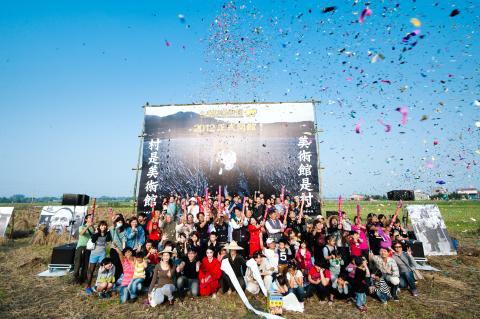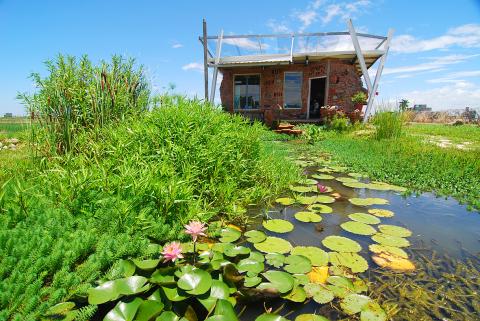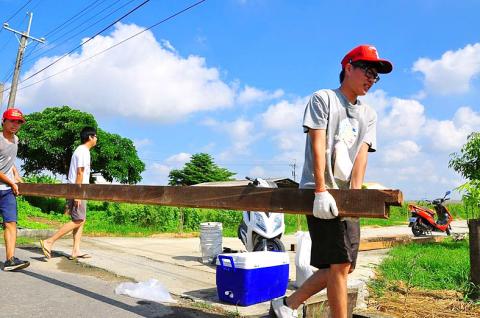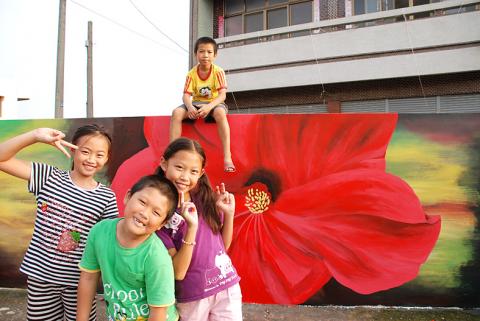At first glance, Tugou (土溝) in Houbi Township (後壁), Tainan County, appears to be a typical farming village on the Jianan Plain (嘉南平原). Traditional sanheyuan (三合院) dot the rural community where residents are mostly children and the elderly. Nearby, paddy fields stretch as far as the eye can see.
But a closer look reveals a communal lounge space decorated with artwork where villagers come to take a tea break, gossip or catch a music performance. By the roadside, residents relax on decorative settees while watching their grandchildren play. Several large-scale black-and-white photographs, located further down the road in the middle of a rice field, depict the wrinkled faces of those who have spent their entire lives tending the land.
These uncommon pictures are part of the opening exhibition launched in December last year by a group of young cultural workers and local residents under the name of Togo Rural Village Art Museum (土溝農村美術館).

Photo courtesy of Tugou Rural Cultural Development Association
“The idea is to see the village as a museum, its landscape and way of life as art. It sums up what we have been doing here for the past decade,” said Lu Yao-chung (呂耀中), one of the organizers who has lived in Tugou for nearly 10 years.
In the beginning
But turning the rural space into an exhibition space hasn’t been easy. With a population of approximately 1,000, Tugou, like most farming villages in Taiwan, has long suffered a “youth drain” — those who move away for school and work, leaving the elderly and youngsters at home. Houses are abandoned; weeds grow everywhere. In 2002, a group of locals in their 30s and 40s decided to take matters into their own hands and established the Tugou Rural Cultural Development Association (土溝農村文化營造協會).

Photo courtesy of Tugou Rural Cultural Development Association
“Our village was declining. There was no sign of development. Not knowing anything about community development, we decided anyway to take responsibility to improve our environment,” said Su Chao-chi (蘇朝基), who has served as the association’s director for many years.
It didn’t take long before Lu, then a student at the Graduate Institute of Architecture at Tainan National University of the Arts (TNNUA), came to the village, having followed the advice of his professor Tseng Shu-cheng (曾旭正), who believed Tugou provided a chance for students and villagers to work together for mutual benefit. Soon, a group of students from TNNUA moved into the farming community.
The first major collaborative effort took shape in 2004 when the students sought help from villagers to build a shed for the village’s last remaining water buffalo, reviving a traditional technique that involves making bricks from clay and straw. A series of community-based projects followed, including the much-praised transformation of a disused pigpen into a public lounge area outfitted with a communal kitchen and a small library-cum-playroom for children.

Photo courtesy of Tugou Rural Cultural Development Association
Another well-known undertaking involved renovations in Jhuzihciao (竹仔腳), one of the six small settlements that comprise Tugou. The project met with success, winning a prize in 2006, awarded by the now defunct Council for Cultural Affairs.
Finding acceptance
But villager acceptance of the young outsiders didn’t come easily. Lu said it was earned through conflict, friction and eventually compromise.

Photo courtesy of Tugou Rural Cultural Development Association
“The first day Lu came to the village, asking what he could do to help, we didn’t pay attention to him. The second day, he chatted with us and made himself useful to the farmers. Then we began to talk about the projects we could work on together,” the 48-year-old Su recalled.
Even though he was born and raised in Tugou, Su said that he has difficulty persuading elderly residents to participate in community-based projects.
“We went to the squares in front of temples and started talking to people. If they were home, we went to their front yards for a chat over tea. We had to develop the ability to tackle criticism and questioning,” he said.
The director believes the main reason behind their success is the association’s open and transparent operation, which “respects everyone’s opinion and makes public all details of each undertaking.”
To Lu, communication is the key, and the association plays an important role in connecting the students with local residents.
“In school, we would use terms such as ambience, site and dimension. Here, when you ask a farmer how he wants the window of his cowshed done, he would say ‘like the size of my TV,’” Lu explained. “The most important lesson I have learned from working here is that if you want to communicate, you have to speak a language that other people understand.”
Chen Yu-liang (陳昱良), one of four former TNNUA students who chose to stay in Tugou after graduation, echoed Lu’s sentiment. Responsible for creating many large-scale installation pieces in the village, Chen points out that their works at Tugou can be epitomized by a couple of mosaic couches standing next to a paddy field in Jhuzihciao.
“It took me three months to place all the small pieces of colored stones onto the couches. But through this process local residents came to recognize and accept what we do here. What is important is not the finished work, but the process of our making it,” Chen said.
“We don’t talk big words. Everything we do is as simple as making chairs for old farmers to sit, chat, appreciate the landscape and be proud of their village,” he added.
Life as art
Over the years, the young architects and artists have made efforts to incorporate their works into local life. For example, the images of Chinese hibiscus painted on the walls by the roadside recall the bygone days when the plants were used by locals as fences. The construction and completion of the mosaic settees were deemed successful only when villagers started to come to rest on them.
To both Lu and Chen, their works over the past 10 years are meant to help local residents regain confidence in what they do and find beauty and value in their rural way of life.
“Every day I see old farmers in their 70s and 80s ride their old rusty bicycles to work in the field. They keep farming because they don’t want their ancestors’ lands to lie fallow and deserted. We want our works to be part of their life, to make it dignified,” said Chen, who, like Lu, has run an architecture and design firm in Tugou for several years.
A decade of work
To Su, the biggest change over the course of the past 10 years is how residents’ perception of the village has changed.
“Before when the farmers saw visitors from outside, they thought they were silly to want to come to this godforsaken place. Now they volunteer to introduce visitors to their hometown,” he said, adding: “Before young people came back once a year. Now they come home once every month or even every week, bringing friends to visit.”
Despite its growing popularity, Tugou has yet to develop tourist facilities. There is no restaurant or cafe, and the nearest accommodation is in the adjacent Baihe Township (白河). With rice production fetching tens of thousands of New Taiwan Dollars a year, local farmers like Su have to work second jobs to support their families.
Lu points out that when they first came to Tugou, they wanted to put into practice all the ideas about community-based industry and sustainable development they learned from school. But the students gradually realized that the villagers have their own pace of doing things.
“Of course, it is something that we have to think about. But what is important is not to answer outsiders’ call to build an industry, but to work happily with the locals,” he added.
When asked how he envisions Tugou’s future, Su said his goal is to have young people coming back and be able to make a decent living.
“What has been done over the past 10 years is an attempt to change people’s hearts and mind. It cannot be rushed. It is only when minds are changed that we can work toward the goal we set out to achieve,” Su said.
Having received a nomination in the visual art category at this year’s Taishin Arts Award, the ongoing exhibition of the Togo Rural Village Art Museum features works by 17 artists that range from paintings, sculptures, photographs to video installations and film screenings. While some art works are located outdoors, most pieces are exhibited inside vacant houses, courtyards and storehouses which are open to the public during weekends and on national holidays from 10am to 4pm. Group tours can be reserved in advance by calling (06) 687-4505.
Individual visitors are welcome to explore the area by bicycles provided by the development association. The village’s grocery stores double as information centers where guide maps and other tourist information are available.
How to get there:
The fastest way is to take the High Speed Rail train to Chiayi station. From there, a taxi ride to Tugou takes 20 to 30 minutes and costs around NT$350. More information can be found at: togoartmuseum.myweb.hinet.net.

May 18 to May 24 Pastor Yang Hsu’s (楊煦) congregation was shocked upon seeing the land he chose to build his orphanage. It was surrounded by mountains on three sides, and the only way to access it was to cross a river by foot. The soil was poor due to runoff, and large rocks strewn across the plot prevented much from growing. In addition, there was no running water or electricity. But it was all Yang could afford. He and his Indigenous Atayal wife Lin Feng-ying (林鳳英) had already been caring for 24 orphans in their home, and they were in

On May 2, Chinese Nationalist Party (KMT) Chairman Eric Chu (朱立倫), at a meeting in support of Taipei city councilors at party headquarters, compared President William Lai (賴清德) to Hitler. Chu claimed that unlike any other democracy worldwide in history, no other leader was rooting out opposing parties like Lai and the Democratic Progressive Party (DPP). That his statements are wildly inaccurate was not the point. It was a rallying cry, not a history lesson. This was intentional to provoke the international diplomatic community into a response, which was promptly provided. Both the German and Israeli offices issued statements on Facebook

Even by the standards of Ukraine’s International Legion, which comprises volunteers from over 55 countries, Han has an unusual backstory. Born in Taichung, he grew up in Costa Rica — then one of Taiwan’s diplomatic allies — where a relative worked for the embassy. After attending an American international high school in San Jose, Costa Rica’s capital, Han — who prefers to use only his given name for OPSEC (operations security) reasons — moved to the US in his teens. He attended Penn State University before returning to Taiwan to work in the semiconductor industry in Kaohsiung, where he

President William Lai (賴清德) yesterday delivered an address marking the first anniversary of his presidency. In the speech, Lai affirmed Taiwan’s global role in technology, trade and security. He announced economic and national security initiatives, and emphasized democratic values and cross-party cooperation. The following is the full text of his speech: Yesterday, outside of Beida Elementary School in New Taipei City’s Sanxia District (三峽), there was a major traffic accident that, sadly, claimed several lives and resulted in multiple injuries. The Executive Yuan immediately formed a task force, and last night I personally visited the victims in hospital. Central government agencies and the